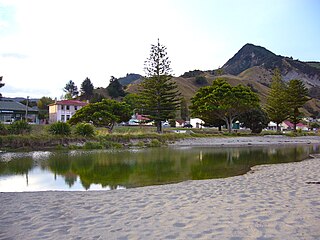Related Research Articles

Tokomaru Bay is a small beachside community located on the isolated East Coast of New Zealand's North Island. It is 91 km north of Gisborne, on State Highway 35, and close to Mount Hikurangi. The district was originally known as Toka-a-Namu, which refers to the abundance of sandflies. Over the years the name was altered to Tokomaru Bay.

Waikanae is a town on New Zealand's Kapiti Coast. The name is a Māori word meaning "waters" (wai) "of the grey mullet".

Ngāti Toa, Ngāti Toarangatira or Ngāti Toa Rangatira, is a Māori iwi (tribe) based in the southern North Island and in the northern South Island of New Zealand. Its rohe extends from Whanganui in the north, Palmerston North in the east, and Kaikoura and Hokitika in the south. Ngāti Toa remains a small iwi with a population of only about 4500. It has four marae: Takapūwāhia and Hongoeka in Porirua City, and Whakatū and Wairau in the north of the South Island. Ngāti Toa's governing body has the name Te Rūnanga o Toa Rangatira.
Te Kauwhata is a small town in the north of the Waikato region of New Zealand, situated close to the western shore of Lake Waikare, some 40 km north of Hamilton.

Ōtaki is a town in the Kapiti Coast District of the North Island of New Zealand, situated half way between the capital city Wellington, 70 km (43 mi) to the southwest, and Palmerston North, 70 km (43 mi) to the northeast.
Te Horo and Te Horo Beach are two localities on the Kapiti Coast of New Zealand's North Island. Te Horo Beach is the larger of the two settlements and, as its name implies, is located on the Tasman Sea coast. Te Horo is located to the east, a short distance inland. They are situated between Peka Peka and Waikanae to the south and Ōtaki to the north. "Te Horo" in the Māori language means "the landslide".

Ngāti Raukawa is a Māori iwi with traditional bases in the Waikato, Taupo and Manawatu/Horowhenua regions of New Zealand. In 2006, 29,418 Māori registered their affiliation with Ngāti Raukawa.

Manunui is a small Whanganui River settlement, about 6 kilometres (3.7 mi) east of Taumarunui on State Highway 4, in New Zealand's King Country. It was once known as Waimarino, but John Burnand of the Ellis and Burnand sawmilling firm renamed it Manunui around 1905.

Te Araroa is a town in the Gisborne Region of the North Island of New Zealand. It is situated 175 km north of Gisborne city, along State Highway 35 between Tokata and Awatere. Te Araroa is the birthplace of noted Māori politician Sir Āpirana Ngata. Māori in the area are generally associated with the Ngāti Porou iwi. It is 100 metres from its local beach.

Muaūpoko is a Māori iwi on the Kapiti Coast of New Zealand.

Wairau Valley is the valley of the Wairau River in Marlborough, New Zealand and also the name of the main settlement in the upper valley. State Highway 63 runs through the valley. The valley opens onto the Wairau Plain, where Renwick and Blenheim are sited. The Alpine–Wairau Fault runs along the length of the valley.

Manakau is a settlement in the Horowhenua District, at the boundary of the Manawatū-Whanganui and Wellington regions of New Zealand's North Island. It lies 8 km north of Otaki and 12 km south of Levin, and is connected to both via State Highway 1, which skirts Manakau's western edge. The township 5 km inland from the coast of the Tasman Sea.

Ranana is a settlement 60 kilometres (37 mi) up the Whanganui River from Whanganui, New Zealand.
Te Whatanui was the leading chief of the Ngāti Raukawa iwi of New Zealand from the 1820s to the 1840s.

Koriniti is a settlement 47 kilometres (29 mi) upriver from Whanganui, New Zealand, home to the Ngāti Pāmoana hapū of the iwi Te Āti Haunui-a-Pāpārangi.

Parikino is a settlement 24 kilometres (15 mi) upriver from Whanganui, New Zealand; the original pā site was across the Whanganui River.

Ohinewai or Ōhinewai is a small settlement in the Waikato Region, in New Zealand. It is located on the east bank of the Waikato River on SH1, 9 km north of Huntly
Moutoa is a rural community in the Horowhenua District and Manawatū-Whanganui region of New Zealand's North Island, on the Manawatu River. It is located Foxton and State Highway 1 in the west, and Shannon and State Highway 57 in the west.
Koputaroa, Koputāroa or Kōputaroa is a rural community in the Horowhenua District and Manawatū-Whanganui region of New Zealand's North Island.
Pakipaki is a village and rural community in the Hastings District and Hawke's Bay Region of New Zealand's North Island.
References
- ↑ Lok, Kara (5 May 2011). "Halls failing to pay their way?". stuff.co.nz. Horowhenua Mail.
- ↑ "Te Kāhui Māngai directory". tkm.govt.nz. Te Puni Kōkiri.
- ↑ "Māori Maps". maorimaps.com. Te Potiki National Trust.
- ↑ "Whenua Viz – Poroutawhao". whenuaviz.landcareresearch.co.nz. Landcare Research.
- ↑ "History Part 2". gw.govt.nz. Greater Wellington Regional Council.
- 1 2 Ballara, Angela. "Te Rangihaeata". Dictionary of New Zealand Biography . Ministry for Culture and Heritage.
- ↑ Ballara, Angela. "Te Rangihaeata". Dictionary of New Zealand Biography . Ministry for Culture and Heritage.
- ↑ Keys, Ben (October 1920). Diary.
- ↑ Hilliard, C (2010). "Licensed Native Interpreter: The Land Purchaser as Ethnographer in Early-20th-Century New Zealand". The Journal of Pacific History. 42 (2): 229–245. doi:10.1080/00223344.2010.501699. JSTOR 25764400.
- ↑ Leonard, C P. "Leonard Collection – Huia Marae". Kapiti Coast Libraries. Kapiti Coast District Council.
- ↑ "Ministry of Education School Profile". educationcounts.govt.nz. Ministry of Education.
- ↑ "Education Review Office Report". ero.govt.nz. Education Review Office.
Coordinates: 40°33′11″S175°16′12″E / 40.553023°S 175.269921°E